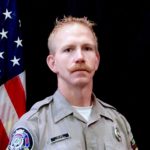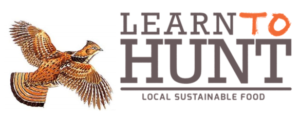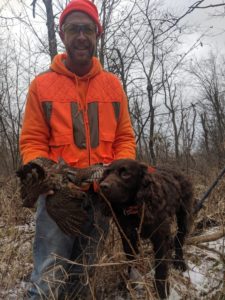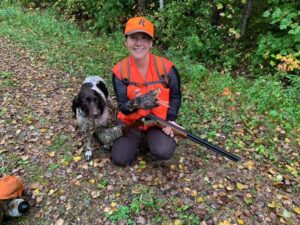An article from WWA’s Words From The Wardens.
This article originally appeared in Wisconsin Waterfowl Association’s March 2020 eNewsletter.
 By DNR Conservation Warden Tim Otto of Langlade County, a 20-year DNR staffer in his 14th year serving Langlade County
By DNR Conservation Warden Tim Otto of Langlade County, a 20-year DNR staffer in his 14th year serving Langlade County
One of the most enjoyable aspects of my state conservation warden career is when I get to experience new hunter firsts. Whether it’s a first deer, duck, largemouth bass, bluegill, or ruffed grouse, it is always a highlight.
 I’m not alone in that enjoyment. My American Water Spaniel, Aldo, is always up for hunts for ducks, geese, ruffed grouse, woodcock or snowshoe hares. If it involves retrieving for me or another, Aldo is at the ready!
I’m not alone in that enjoyment. My American Water Spaniel, Aldo, is always up for hunts for ducks, geese, ruffed grouse, woodcock or snowshoe hares. If it involves retrieving for me or another, Aldo is at the ready!
The Wisconsin Department of Natural Resources is also on a hunt as it seeks to recruit, retain and reactivate new hunters and anglers. This effort is known as R3. I have been involved in several recruiting-type events as part of this R3 program – and that’s what this column is about.
I’ve helped with youth field days, youth turkey hunts, Learn to Trap events and currently I’m the lead instructor for a hunter education group.
I’ve noticed there is willingness for people to learn an activity, such as waterfowl hunting. However, there isn’t a means for them to participate without someone else’s help. The R3 community acknowledges nobody can learn to hunt in one weekend. It can take many opportunities for someone from a non-hunting background to feel comfortable heading out on their own.
R3 research nationwide shows the greatest interest in becoming new hunters and anglers comes through urbanesque young adults. These young adults are becoming more and more concerned about where their food comes from and how it’s handled. They also make up a demographic who has the time and money to take up a new hobby before possibly starting families.
Brainstorm leads to Learn to Hunt for Food with upland focus
About two years ago, I began to brainstorm with dog-owning hunting friends and the concept of a Learn to Hunt for Food with an upland focus was born.
There are a lot of common concepts in an upland LTH and a waterfowl LTH. Because of common threads, such as shot gunning and dogs, there could be collaboration between upland and waterfowl groups.
When it comes to the food, I serve upland birds, waterfowl and other small game to the participants. My hope is that if they don’t care for a particular type of hunting, perhaps a spark can be lit for some other game species based upon a food interest.
LTH for Food starts and teaches the teacher, too

A LTH participant with his first ruffed grouse with Aldo, Warden Otto’s American Water Spaniel. Aldo flushed it and retrieved it.
My overarching goal of the program was to remove as many of the barriers that prevented someone from hunting. At the time of the idea’s conception, I didn’t know half of what those barriers were, which meant I was learning along with the participants.
Such as the day the classroom discussion turned to ruffed grouse identification. I flippantly commented that if someone hears a loud commotion, they get scared and see something flying away, they should shoot it. One participant asked: “So, if I’m scared in the woods, I should shoot it?” I realized at that moment I shouldn’t take for granted any piece of knowledge I have from a lifetime of hunting. Of course, I recalled, we always need to remember the four rules of firearm safety – TABK. Knowing your target, what’s in front of it and what’s behind it, is one of those key safety rules.
Why the focus on food? Many non-hunters recognize the environmental and health benefits of harvesting local food in a sustainable manner. Also, I believe the component of food culture plays a role in hunter recruitment.
This was cemented for me during a hunter education field day I was teaching at a few years ago. On the Saturday of our class, every instructor brought some kind of wild game for the rest of us to enjoy. Instructor’s choice!
Over the years and the classes, we’ve enjoyed smoked salmon, walleye, barbecued elk, venison steaks, dove, venison burgers and more on these Saturdays.
I’ve learned that when I email the likely menu for the class that includes wild duck served with a black currant sauce, anybody who was on the fence about attending will redouble their intentions.
For a long time, I was a bread-and-fry guy and a ‘yeah, it tastes good in bacon’ cook. There are an amazing number of great wild game cookbooks, websites and other resources available that have upped my culinary game. It’s amazing what maple syrup glaze on a grouse does to impress folks.
Looking for a new hunting partner? Contact me!
Another lesson I’ve learned is mentors are at a premium. The more help I can get the better.
It takes a lot of people to pull off teaching wingshooting, running dogs, teaching in a classroom setting, cooking and having someone who will take an eager novice on a hunt.
I am trying to build a cadre of mentors who will take these novices hunting outside of the class. This is to try and envelop a budding hunter into the culture and have a support network. A new hunter can’t be expected to have a dog, honey hole, shotgun, other gear and skills after a single hunting experience.
I’ve learned these prospective hunters don’t have anywhere to specifically hunt and how important it is to have a mentor take the student to a location an aspiring hunter can go independently. Although I’m disinclined to divulge my honey holes as much as the next person, I ask myself: “What’s worse: Divulging a honey hole or having the honey hole destroyed by a lack of appreciation?”
I’m trying to create a network of mentors through sports groups and other places. A class participant has started a Facebook group for mentors and novice hunters to keep in touch and plan outings.
Class structure can change – and has!
In the past, the class was structured to have two classroom meetings, a field trip where we demonstrate spaniels and pointers’ unique hunting styles, and three trap range days. Then, on a weekend day we gather and plant pheasants for the group to hunt in a controlled manner.
In the fall, students are taken on a wild ruffed grouse hunt at least once during the first nine days of the season. Last year in a mid-program adjustment, I added a field trip session for foraging since many people wanted to learn about that and I had a willing instructor. We also added trap range days prior to the September hunt. Hunter education is not a requirement for participating. By having the beginnings in the spring, it allows interested participants an opportunity to take a hunter education class during the summer.
One adjustment I’m considering making this year is to find a way to accommodate more people’s schedules. In the past, I required attendance at all classroom sessions, the field trip, and at least two trap shooting days. I’ve had requests from people that were enthusiastic about attending, but had scheduling conflicts or were from out of the area. With my instructors and mentors, I’m going to figure a way to be more flexible yet ensure that everyone gets enough knowledge and a maximal amount of safe gun handling practice.
If anyone has any questions or wants to chat about my specific program, they can contact me at (715) 623-4190 x.3132.
There also is the DNR’s website https://dnr.wi.gov/ and use the keyword search R3.

